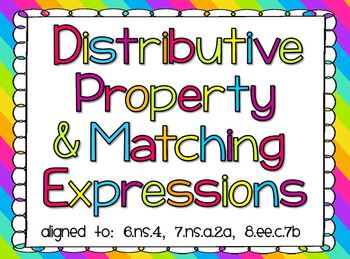Distributive Property with Equivalent Expressions and Area Models
Felicia Purdy
1.5k Followers
Grade Levels
5th - 8th
Subjects
Resource Type
Standards
CCSS6.NS.B.4
CCSS7.NS.A.2a
CCSS8.EE.C.7b
Formats Included
- Zip
Pages
17 pages
Felicia Purdy
1.5k Followers
What educators are saying
I used this with small groups. Have to match 4 cards helped students to see the various models and expressions they would see when using the distributive property.
Thank you for the resource. This really allowed my students to gain a deeper understanding of the skills and show what they had learned and mastery of the topic.
Description
This bundled lesson includes a PPT (saved as a PDF) for introducing matching area models with equivalent expressions. In my classroom, I use CPS (clickers) and the students vote on which expression is equivalent to the area model shown. Each area model has a matching addition expression {72+ 81}, expanded distributive property expression (9 x 8) + (9 x 9), as well as a distributive property expression in which they must factor out a common factor 9(8+9).
At the end of the whole group lesson, there is a model example of the Formative Assessment Matching Activity cards.
During "work" time, your students will match the area model and all three expressions that are equivalent (See Picture for Example of how I color code my cards).
At the end of the whole group lesson, there is a model example of the Formative Assessment Matching Activity cards.
During "work" time, your students will match the area model and all three expressions that are equivalent (See Picture for Example of how I color code my cards).
Total Pages
17 pages
Answer Key
N/A
Teaching Duration
N/A
Report this resource to TPT
Reported resources will be reviewed by our team. Report this resource to let us know if this resource violates TPT’s content guidelines.
Standards
to see state-specific standards (only available in the US).
CCSS6.NS.B.4
Find the greatest common factor of two whole numbers less than or equal to 100 and the least common multiple of two whole numbers less than or equal to 12. Use the distributive property to express a sum of two whole numbers 1–100 with a common factor as a multiple of a sum of two whole numbers with no common factor. For example, express 36 + 8 as 4 (9 + 2).
CCSS7.NS.A.2a
Understand that multiplication is extended from fractions to rational numbers by requiring that operations continue to satisfy the properties of operations, particularly the distributive property, leading to products such as (–1)(–1) = 1 and the rules for multiplying signed numbers. Interpret products of rational numbers by describing real-world contexts.
CCSS8.EE.C.7b
Solve linear equations with rational number coefficients, including equations whose solutions require expanding expressions using the distributive property and collecting like terms.





